|
July 16, 2022
Dear Neighbors and Friends,
I hope that you and your loved ones are doing well, staying healthy, and looking out for your neighbors and friends during this past week.
Summer is with us now. I don’t need to tell you that the weather has turned lovely here in Oregon, as we experience the lingering effects of a “La Niña” year. Our wet spring and moderate temperatures in the early summer have delayed the start of fire season in the Northwest, but we can’t count on that lasting much longer. As you’ll see further down in the newsletter, areas in Oregon that have been plagued by climate-induced drought in recent years will be especially at risk in the coming weeks. Wildfires will return, and we need to prepare for them in a variety of ways.
Compared to other parts of the country and other parts of the world, however, we have so much to be grateful for. Remembering what it felt like last year during the “heat dome” here, it’s unfortunately all too easy to imagine having to live (albeit briefly for now) under such extreme weather. It’s important that we do so.
To view such events as freakish and rare, or even rare but to be expected from time to time would be a mistake. In the words of Professor Petteri Taalas, the Secretary-General of the World Meteorological Association, “Human induced climate change amplifies the impacts of naturally occurring events like La Niña and is increasingly influencing our weather patterns, in particular through more intense heat and drought and the associated risk of wildfires – as well as record-breaking deluges of rainfall and flooding.” It’s by no means too late for us to address climate change, of course, committing to doing what we can to reduce our emissions and preventing the worst from occurring; but we also need to prepare for the changes that are already “baked in.”
On a happier note, summer is also a time for kids to have fun and learn new things at the same time. Thanks to action by the Legislature, more of Oregon’s kids are able to do that right now. You’ll find an update on this year’s summer learning programs in this week’s newsletter as well. Early reports are very positive.
On the COVID front, you’ll see that the Omicron phase of the pandemic continues to be in a holding pattern. We’re no longer seeing big increases in cases and hospitalizations, but we’re also not seeing the rapid declines that we saw following earlier surges. With the highly transmissible Omicron BA.5 subvariant now dominant in Oregon, and more people traveling and attending events, large numbers will continue to test positive, hopefully without severe consequences. Most of Oregon’s counties are considered to be at High Risk this week, and that includes Lane County, where the World Athletics Championships are going on. Further down in the newsletter you can read about the wastewater monitoring that has been underway in Eugene in an effort to stay on top of that potential risk.
You’ll also see that this week’s wastewater monitoring for the state as a whole actually has good news for us. The amount of virus in most cities has plateaued or gone down. We’ll see if that continues.
More on all this in the various graphs, reports, and links in this week’s newsletter.
Until next time, please stay healthy and safe. And let me know if you have any questions or thoughts about anything in tonight’s newsletter.
An Update on Summer Programs in Oregon
I was out for a walk the other day and happened to pass a schoolyard full of young children involved in a variety of structured activities. It hit me that these kids were the beneficiaries of the Legislature’s recent big appropriation for summer learning. After all the work by so many people that it took to get that package designed, approved, and out the door, it was so gratifying to see it really happening.
You’ll remember that this is the second year that the Legislature has been able to make a big investment for summer learning, most of it coming from COVID-relief funds designed to lessen the impact of COVID on student learning. Of the $150 million that was allocated for summer programs this year, two-thirds are for programs being run through the schools and a third for programs run through various local community-based organizations.
This summer’s programs are taking place all over the state. If you’re curious about which school districts received funding and how much, here’s the list of all the K-8 allocations, and here are the high school allocations. They are being run by the districts themselves or in partnership with local nonprofits. You’ll find lots of information about summer learning at the Department of Education summer learning website.
You may remember that we had a hiccup with insurance for the programs run through community-based organizations, intended to receive the remaining $50 million in funding. I reported earlier that the insurance barrier was at last resolved in early June, but it was unclear whether or not the community-based organizations would be able move forward at that late date. Well, it now appears that they were able to step up and get it done. I just heard from the ODE Director that $37 million has already gone out the door to 275 local organizations. Yesterday was the deadline for final requests, and he feels confident that the remainder of the $50 million will soon be allocated as well.
These community-based enrichment programs are being overseen by the Oregon Association of ESDs. Here’s a link to their website Here's a link to their website about this wonderful program. Take a look, and you’ll be encouraged that we’re doing the right thing here in Oregon.
For a sense of how the programs are playing out here in the Portland Metro region, here's a recent article from the Oregonian.
We know that the pandemic has been especially hard for kids from low-income families and kids with disabilities. The request for proposals that went out in April let districts and organizations know that the programs most likely to be funded were those that focused on these kids. That appears to be what has happened. Senate Education will be receiving reports in the fall to get a better sense of all that is being accomplished.
Summer is always a time when kids from less-affluent families are at risk of falling farther behind with learning loss. These summer programs, funded by the state in partnership with local school districts, have the potential to turn that around.
If, as we hope, these programs prove their value, the next step will be to dedicate the funding to allow them to continue on a regular basis. More on that to come.
Wildfire Report: Entering the Risky Season
Legislators heard from Mike Shaw (Chief of Fire Protection for the Oregon Department of Forestry) last week with a status report on this year’s fire season in Oregon. It’s a blessing and a throwback in time to have the first such report coming to us after the 4th of July! With the return of more typical summer weather, we cannot count on that continuing, at least not in large parts of the state (especially in Southern and Eastern Oregon).
Here’s what we learned:
As you are aware, the 2022 fire season has been delayed due to cooler than average temperatures for this time of year, but as we move deeper into the traditional fire season timeframe, conditions will change rapidly. All ODF districts and associations will be in closed fire season as of next Monday the 11th of July, initiating both public and industrial restrictions across the state. We are still in the early stages of fire season so firefighting resources are available and positioned accordingly to respond to emerging fires. This includes all exclusive use contracted severity aircraft which will be available by July 15.
Fire Weather Forecast: The recent weather, which has produced some lightning and showers over the past week, is expected to end after today. This will mark a change in our weather pattern to above-normal, hot and dry conditions next week. The potential for new large fires is anticipated to remain generally low across the geographic area due to the persistent cooler and wetter weather; however, the agency has responded to multiple lightning caused fires from the last weather system that passed through the state. As these hotter and drier conditions continue, we expect to see an increase in fire behavior for new starts. The recent Willow Creek fire in eastern Oregon is a great example of how a fire start in the wrong area can become problematic very quickly. Preventing any human caused fire remains a major focus for ODF.
Longer-term forecasts continue to place Oregon in an above average fire season with the state’s persistent drought conditions as a major driver. Much of the state remains in severe to extreme drought conditions with southwest (Medford), south central (Klamath), and the eastern slopes of the Cascades in extreme or exceptional drought, which leads to the area with the greatest risk for large fire spread at this time.
More on Wildfire: World Premiere of a Film Focused on Oregon
By the way, a new documentary by local filmmakers that focuses on wildfire in Oregon has its world premiere this week in Portland at the Hollywood Theatre. Elemental examines competing theories about the best way to deal with fire in our forests. I’ve heard great things about it. The film will be followed by Q&A with the filmmakers and perspective from some of my legislative colleagues. I can’t be there myself, as I need to be in Ashland that day for Higher Ed Task Force meetings, but I’m eager to see it as soon as I get back.
Here’s info about it:
Join us for the World Premiere of Elemental, a film that invites you to reimagine your relationship with wildfire through the eyes of top scientists and indigenous fire managers who are leading the way toward living with this essential element.
Doors open at 7PM for the red carpet celebration and screening at 7:30. Stay after the show for a lively discussion and Q&A session with the filmmakers, Oregon State Senator Jeff Golden, State Representative and firefighter Dacia Grayber, and an indigenous fire expert. The event is presented by Film Action Oregon and co-hosted by Senator Golden and Representatives Dacia Grayber and Khanh Pham. As the Eagle Creek Fire burned in 2018, Portland filmmakers Trip Jennings, Sara Quinn, and Ralph Bloemers took to the air and the ground to help the community make sense of the fire. Their work led to a deep investigation of wildfire in a hotter, drier, more crowded world, and includes the 2020 wildfires that burned across one million acres and destroyed numerous communities.
Five years in the making, Elemental is the product of their journey across the United States and into fire affected communities. Produced and edited in Portland, Narrated by David Oyelowo (Emmy & Golden Globe Nominee), supported by National Geographic and Patagonia. With fire seasons growing more destructive and more deadly, the time is now to face the danger and do something that changes how we live with fire. The way we respond to this risk will have long-term effects on our communities, forests, and - perhaps most importantly - climate. Join us for the world premiere and in charting a new path forward.
Details:
July 20th Doors 7PM
Hollywood Theater
4122 NE Sandy Blvd
Tickets On Sale Now: $10
10% of ticket sales go to fire-affected communities
Film Website: https://www.elementalfilm.com/
Film Trailer: https://vimeo.com/696775450
ON THE COVID FRONT
Weekly Data Report:
Overall, infections, hospitalizations, and deaths have gone up somewhat in the last week, while test positivity has gone down. We appear to remain in the “COVID Crest” for now.
- The number of reported infections has risen slightly. OHA reported 9,955 new cases of COVID-19 during the week of July 8-14 (vs. 9,687 the week before), a 7-day average of 1,422 per day (vs 1,384 the previous week). The number of new cases is again likely an undercount, as many people are using home tests to determine their infection status but are not reporting those results.
- Average test positivity for the last week was 14.2%, a reduction from the previous week’s 15.9%. Again, this number skews high because it likely reflects a higher proportion of people showing COVID symptoms (and thus going in for a test, rather than self-testing).
- On Thursday there were 458 COVID-19-related hospitalizations statewide, vs. 423 last Thursday. This is lower than the 479 peak that was forecast for July 12 in the last OHSU report. Again, many of these hospitalizations are not in and of themselves due to COVID—they include those who tested positive after having been admitted for other reasons.
- The number of COVID patients in Oregon’s ICUs was 63 on Thursday, a small increase from last week’s 59. These are the most serious COVID infections.
- There were 58 COVID-19-related deaths reported during the last week, vs. 26 last week. Again, that doesn’t mean that 58 people died of COVID during the last week: they include late-reports from earlier weeks. COVID deaths remain relatively low during this phase of the pandemic.
OHA Biweekly Report
Now for a 2-week perspective. OHA used to provide weekly summative reports, but now they are only reporting every other week. This was a reporting week.
The COVID-19 Biweekly Data Report, released on Wednesday, showed an increase in COVID-19-related cases and hospitalizations and a slight decrease in deaths when compared to previous 2-week periods.
- Oregon Health Authority reported 21,484 new cases of COVID-19 from June 26 to July 8, a 5.3% increase over the previous biweekly total of 20,410.
- Over the last six weeks, reported hospitalizations have increased slightly while deaths have decreased slightly.
- During the two-week period of June 26 to July 8, test positivity was 15.1%, up from 13.6% in the previous two-week period.
Wednesday’s COVID-19 Biweekly Outbreak Report shows 225 active outbreaks in care facilities, senior living communities and congregate care living settings. Nineteen Oregonians in these settings died of COVID-related illness over the last two weeks.
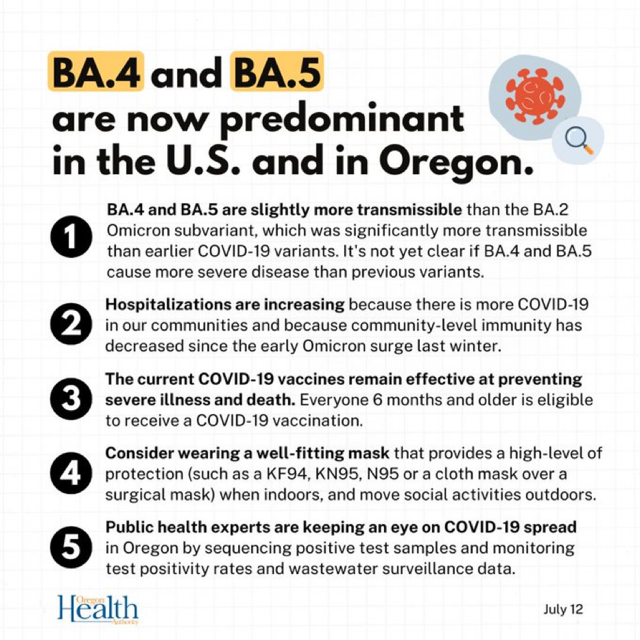
Weekly County Report: The Number of Counties at High Risk Back Up
OHA is no longer providing a weekly county report each Monday, but there are still ways to track this data. According to the CDC Daily Counter (updated each Thursday), 21 (up from 14 last week, nearly as many as 24 from two weeks ago) Oregon counties are now at high risk of COVID transmission, a status that reflects both the number of new COVID cases and the number of people in hospital for COVID: Baker, Benton, Coos, Clackamas, Columbia, Curry, Douglas, Jackson, Josephine, Klamath, Lake, Lane, Malheur, Marion, Multnomah, Polk, Tillamook, Umatilla, Union, Wallowa, and Washington. The CDC recommends that people wear masks in public indoor settings in those counties.
Here’s what the CDC recommends for this category: Stay up to date with COVID-19 vaccines. Get tested if you have symptoms. Wear a mask if you have symptoms, a positive test, or exposure to someone with COVID-19. Wear a mask on public transportation. You may choose to wear a mask at any time as an additional precaution to protect yourself and others. If you are at high risk for severe illness, consider wearing a mask indoors in public and taking additional precautions.
Twelve Oregon counties (down from 15) have reported infection rates that place them in the Medium Risk category: Clatsop, Crook, Deschutes, Grant, Harney, Jefferson, Lincoln, Linn, Morrow, Sherman, Wasco, and Yamhill.
The remaining 3 Oregon counties (down from 7)--Hood River, Gilliam, and Wheeler--remain at Low Risk.
Again, we must remember that these are only the tests results that have been reported. With the prevalence of home tests, there are certainly many more positive cases out there that have not been reported.
We can also track the test positivity rates for each county at this dashboard. The test positivity rates reported this week show continued increases.
Among the reported cases, the statewide infection rate has gone down, from 15.9% last week to 14.2% this week.
At 13.2%, Multnomah County remains where it was last week.
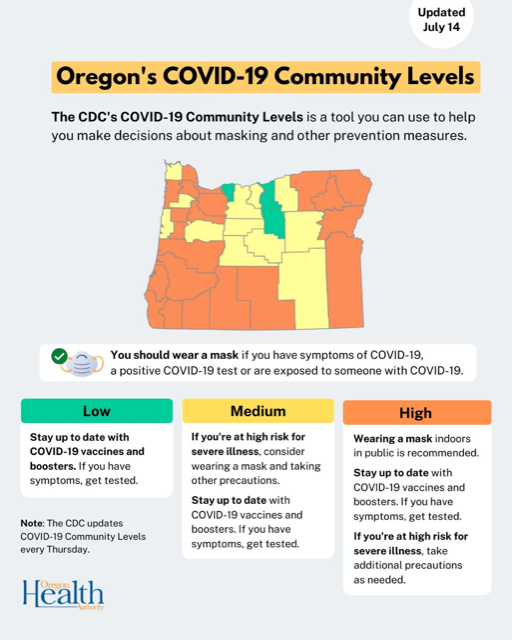
This Week’s Wastewater Monitoring Report Shows a Big DEcrease in Number of Cities with Steady COVID Increases
With testing reports giving us just a fraction of infections out there, wastewater monitoring has become a more reliable indicator of the amount of virus in cities around the state. That report is updated each week.
This week’s report shows us that the following 9 cities (down from 9) are showing sustained increases: Portland and Pendleton.
Most cities surveyed continue to show a plateau of detected virus, with sustained decreases in Bend. Good news!!! (at least for this week . . .)
And Speaking of Wastewater: What Does It Tell Us About the World Athletics Championships in Eugene?
Lane County is currently among those Oregon counties deemed to be at High Risk by the CDC. With thousands of people coming to Eugene right now for the World Athletics Championships (the event opened on Friday), many are concerned about the COVID repercussions. Here’s a communication from OHA:
The World Athletics Championships in Lane County, July 15-24, will feature some of the planet’s greatest track athletes competing at the University of Oregon’s Hayward Field, with tens of thousands of expected attendees coming from across the country and the world.
For scientists who track the spread of diseases, the event also offers a perfect real-time laboratory for monitoring viruses in the sewage, including SARS-CoV-2, the virus that causes COVID-19.
During the event, Oregon Health Authority (OHA), in collaboration with Lane County Public Health and its university research partners, will share daily results from special sewage monitoring in Eugene. Testing will be performed for COVID-19 and other viruses of interest, including influenza, hepatitis A, hepatis E, measles and MERS-CoV.
The COVID-19 pandemic has highlighted risks of international travel and large gatherings in spreading communicable diseases. “An international sporting event that brings together people from different countries provides scientists, public health experts and state and local partners a perfect opportunity to evaluate this population monitoring system used widely in Oregon and across the United States,” says Melissa Sutton, M.D., medical director of respiratory viral pathogens at OHA. “We’ll be able to see how accurate our system is in detecting SARS-CoV-2 variants as well as other viruses that may be present outside of Oregon and even the United States, and that may arrive with travelers.”
Each day during the championships, wastewater will be collected and tested, with results available within 48 hours on a new OHA webpage. The webpage will be published on Friday afternoon. It will resemble Oregon’s SARS-CoV-2 Wastewater Monitoring dashboard.
Pre-event sampling has detected hepatitis A in Eugene.
“Cases of hepatitis A occur sporadically in Lane County; therefore, finding hepatitis A virus in a sewage sample that was collected well before the World Championships even started is not a surprise,” said Lane County Senior Public Health Officer Dr. Patrick Luedtke. “This finding does, however, highlight the opportunity for our community to get protected. Hepatitis A vaccines are readily available, highly effective and have been used with great success for decades.”
Hepatitis A is a vaccine-preventable disease that causes liver inflammation, nausea, stomach pain and other symptoms. It is spread by person-to-person contact and eating contaminated food or drink. Vaccination is the best prevention against hepatitis A, and vaccination has been recommended for Oregon children since 1999. Hand washing and food hygiene also help prevent transmission.
Oregon’s wastewater surveillance program, now operating in more than 40 communities, operates as a partnership between OHA, OSU and wastewater treatment facilities statewide.
Looking at COVID Impacts by Age, Race, and Ethnicity: Improvements, But Inequities Remain
OHA is publishing an updated quarterly report on age-adjusted rate ratios of COVID-19 cases, hospitalizations and deaths by race and ethnicity over time. Age adjustment is a method used to quantify inequities among different racial and ethnic groups. When adjusted for age, people from Pacific Islander/Native Hawaiian, Latinx, Black and American Indian/Alaska Native communities have experienced disproportionate rates of COVID-19 cases, hospitalizations and death. These inequities were acutely pronounced earlier in the pandemic and have decreased over the course of the pandemic. You’ll see, however, that inequities in COVID-19 cases, deaths and hospitalizations for communities of color and tribal communities continue.
Here are some of the highlights:
- Inequity among racial groups was highest in Quarter 2 of 2020. This inequity in case rates has declined over time.
- American Indian/Alaska Native and Black persons have been consistently more likely to be infected with COVID-19 than white persons.
- Hispanic persons were much more likely than white persons to be hospitalized with COVID-19 before April 2021. More recently, inequities between ethnic groups have been smaller.
- American Indian/Alaska Native, Black and Pacific Islander persons are still more likely to be hospitalized with COVID-19 than white persons.
- Hispanic persons were more likely than white persons to die with COVID-19 before April 2021. More recently, inequities between groups have been smaller.
- American Indian/Alaska Native, Black and Pacific Islander persons were more likely than white persons to die with COVID-19 in the period ending April 2021. Inequities between groups have been smaller in the more recent time period, but remain substantially elevated for American Indian/Alaska Native and Black persons.
- OHA believes that the improvements in inequities may be due to vaccination uptake, community efforts, and individual choices that reduce risk.
Additional COVID Updates and Links
- Of all health professionals, pediatricians are at or near the top for job satisfaction. But that doesn’t mean that the work doesn’t have its challenging moments. Especially when it's time to talk about vaccines. Here’s some good advice on how to make that a successful experience.
- Speaking of pediatricians, I happen to have a legislative colleague who is one in her day job: Rep Lisa Reynolds. I recommend that you check out her latest newsletter. It’s full of good info on the COVID front.
- Here’s a deep dive into the BA.5 Omicron variant from the A very good overview of the variant and what we know about it.
- As BA.5 spreads, the COVID experts in the White House warn us that our confrontations with COVID are not over.
- The BA.5 variant is causing many of the same impacts here in Oregon.l as it has been nationwide. Here are details from Gary Warner of the Oregon Capital Insider.
- And here’s some practical advice on BA.5 from OPB.
- The FDA has now authorized use of Novovax as a COVID vaccine. The vaccine has a good success rate, and it does not use the (highly effective) RNA technology that has provoked hesitancy in some as a result of its relative newness. For now, the recommendation is that it only be used as a primary vaccine, not an additional booster. The CDC will likely take action on it in the coming days.
- There’s an alternative to imported, disposable face masks. It’s made in America, lasts a long time, looks weird, but is very comfortable. Many believe it should be the PPE of choice for health professionals. Here's more about the elastomeric respirators.
- Among the many things we’ve learned from the COVID pandemic, the initial closures (aka the “Anthropause”) have provided us with lessons about the impacts of humans on the natural world. Many of the effects of the “Anthropause” were positive, but not all.
- We are continuing to see vaccinated people dying of COVID. Does that mean the vaccines are ineffective? A recent piece in The New Republic helps us understand what's going on.
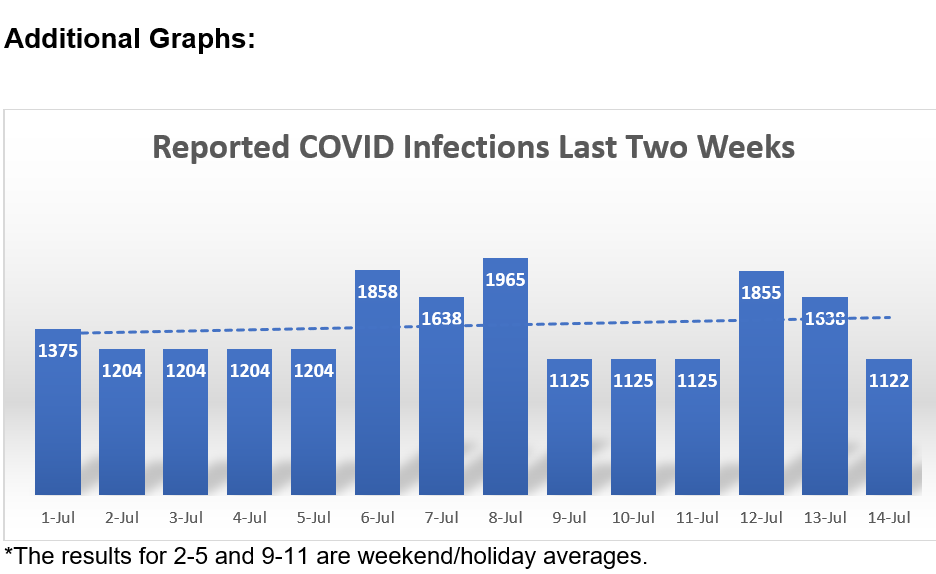
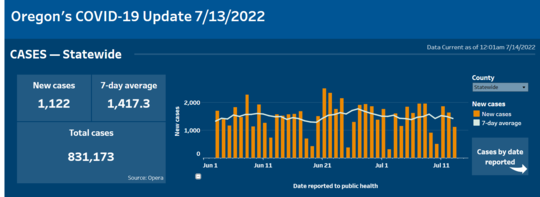

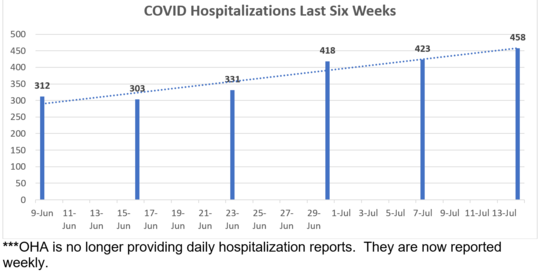
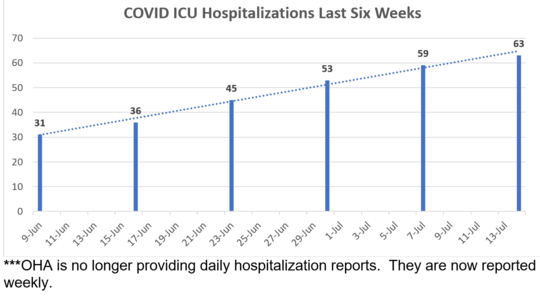 
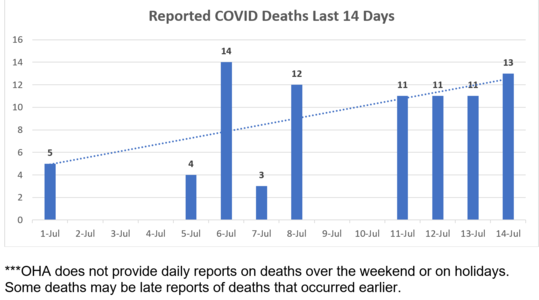

Here again are some COVID resources that you will find useful:
If the above links are not providing you with answers to your questions or directing you to the help that you need, please consider me and my office to be a resource. We’ll do our best to assist you or steer you in the right direction.
Want to See Past Newsletters?
If there was COVID-related information in a past newsletter that you want to go back to, but find you’ve deleted it, you can always go to my legislative website (senatordembrow.com), click on “News and Information,” and you’ll find them all there. Also, if someone forwarded you this newsletter and you’d like to get it directly, you can sign up for it there.
Best,
 Senator Michael Dembrow
District 23
email: Sen.MichaelDembrow@oregonlegislature.gov
web: www.senatordembrow.com
phone: 503-281-0608
mail: 900 Court St NE, S-407, Salem, OR, 97301
|